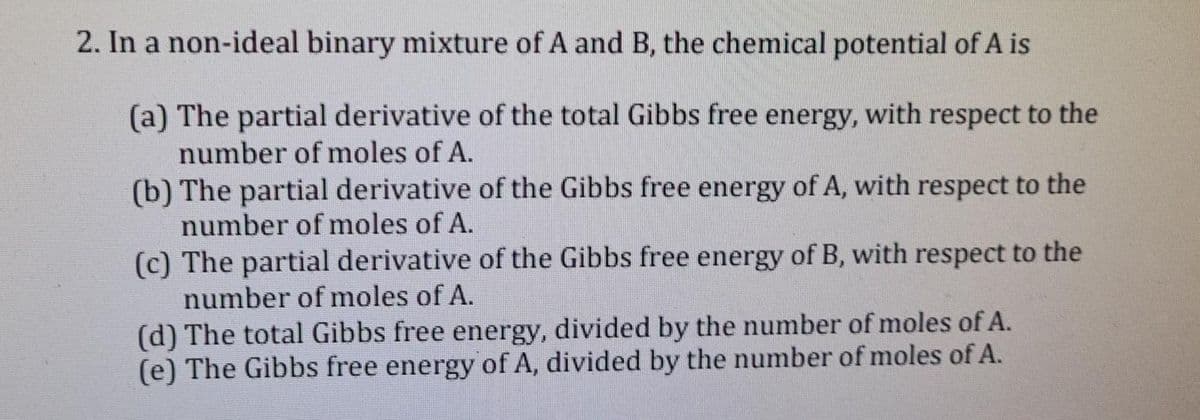2. In a non-ideal binary mixture of A and B, the chemical potential of A is (a) The partial derivative of the total Gibbs free energy, with respect to the number of moles of A. (b) The partial derivative of the Gibbs free energy of A, with respect to the number of moles of A. (c) The partial derivative of the Gibbs free energy of B, with respect to the number of moles of A. (d) The total Gibbs free energy, divided by the number of moles of A. (e) The Gibbs free energy of A, divided by the number of moles of A.
2. In a non-ideal binary mixture of A and B, the chemical potential of A is (a) The partial derivative of the total Gibbs free energy, with respect to the number of moles of A. (b) The partial derivative of the Gibbs free energy of A, with respect to the number of moles of A. (c) The partial derivative of the Gibbs free energy of B, with respect to the number of moles of A. (d) The total Gibbs free energy, divided by the number of moles of A. (e) The Gibbs free energy of A, divided by the number of moles of A.
Chemistry: The Molecular Science
5th Edition
ISBN:9781285199047
Author:John W. Moore, Conrad L. Stanitski
Publisher:John W. Moore, Conrad L. Stanitski
Chapter16: Thermodynamics: Directionality Of Chemical Reactions
Section: Chapter Questions
Problem 88QRT: Billions of pounds of acetic acid are made each year, much of it by the reaction of methanol with...
Related questions
Question
100%

Transcribed Image Text:2. In a non-ideal binary mixture of A and B, the chemical potential of A is
(a) The partial derivative of the total Gibbs free energy, with respect to the
number of moles of A.
(b) The partial derivative of the Gibbs free energy of A, with respect to the
number of moles of A.
(c) The partial derivative of the Gibbs free energy of B, with respect to the
number of moles of A.
(d) The total Gibbs free energy, divided by the number of moles of A.
(e) The Gibbs free energy of A, divided by the number of moles of A.
Expert Solution
This question has been solved!
Explore an expertly crafted, step-by-step solution for a thorough understanding of key concepts.
Step by step
Solved in 2 steps

Knowledge Booster
Learn more about
Need a deep-dive on the concept behind this application? Look no further. Learn more about this topic, chemistry and related others by exploring similar questions and additional content below.Recommended textbooks for you

Chemistry: The Molecular Science
Chemistry
ISBN:
9781285199047
Author:
John W. Moore, Conrad L. Stanitski
Publisher:
Cengage Learning

Physical Chemistry
Chemistry
ISBN:
9781133958437
Author:
Ball, David W. (david Warren), BAER, Tomas
Publisher:
Wadsworth Cengage Learning,

Chemistry: The Molecular Science
Chemistry
ISBN:
9781285199047
Author:
John W. Moore, Conrad L. Stanitski
Publisher:
Cengage Learning

Physical Chemistry
Chemistry
ISBN:
9781133958437
Author:
Ball, David W. (david Warren), BAER, Tomas
Publisher:
Wadsworth Cengage Learning,